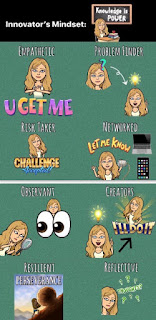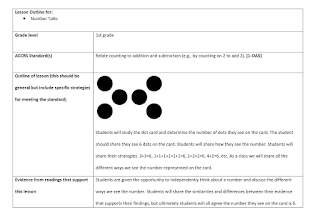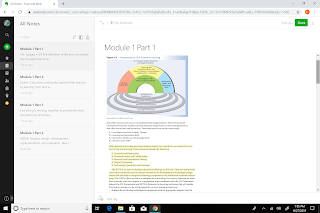Posts
IM Details
- Get link
- Other Apps

The Innovator’s Mindset consists of eight characteristics. I used Bitmojis of myself and some emojis to create the graphic describing the eight characteristics. I also used Picollage to compose my graphic. The first characteristic of The Innovator’s Mindset is empathetic. This is how we understand our students and differentiate our instruction as educators to best meet each students need in the classroom. The best example I saw on the blog was that we must put ourselves in each student’s shoes. If we do not understand our students and the way they each learn, we cannot provide the best learning environment for each student. The second characteristic is being a problem finder or problem solver. We as educators start with a question, not an answer according to the text and the blog. This is what creates a great mindset for educators as we drive our instruction for each student. The third characteristic of The Innovator’s Mindset is being a risk taker. Always be willing to try new tea
Module Three
- Get link
- Other Apps

Part I - Quality Questioning Responses In chapter one, page nine definitely stood out to me because students should know answering a question incorrectly is fine. It is part of the learning process. The steps to the Quality Question cycle are preparing the questions, presenting the questions, prompting thinking, process responses, and polish questioning practices. I use partner sharing in my classroom all the time. I love when students can teach each other concepts as well. It opens up a world of possibilities for the students to gain an understanding of a concept from their peers. I will definitely commit to using this in the future in my classroom because it allows planning of two to four great questions for students to explore and engage in to demonstrate their understanding of a topic or concept. Students are given more opportunities to scaffold with the teacher’s guidance if needed through prompting. Students are given multiple opportunities to answer the question correctly. It
Module Two
- Get link
- Other Apps
"How does instructional design impact P-12 student learning?" The instructional design impacts P-12 student learning in a positive manner and starts in tier one. The direct instructional model can be applied throughout any tier of instruction to best benefit students. In literacy, I see guided practice happen all the time in a small group setting called guided reading. This develops student’s reading fluency and comprehension skills that best meet the students needs. The teacher is modeling how to read in whole group literacy and in guided reading providing a reteach of skills to students if needed for best practices in literacy instruction. I have also seen direct instruction throughout all concepts across multiple grade levels. In first grade, the first grade teachers use it to also teach procedural concepts such as ways to follow our school rules which are being respectful, responsible, problem solver, and safe. The educators model what this looks like, they create
Module One
- Get link
- Other Apps

Part I - Essential Question What is 21st Century Teaching and Learning? The framework built around 21st century learning is made up of different parts working together. These parts consist of core subjects and 21st century themes, learning and innovation skills, information, media, and technology skills, and life and career skills. Referring back to Bloom’s Taxonomy, students start at remembering information and start to demonstrate their full understanding of a center topic when the students are able to create something with the understanding of a certain topic and/or concept. To do this in today’s fast developing technological world and workplace students have to develop different skills to support their learning through common core standards that are intivate for the students. According to the text, this is done by better align college and work expectations in the K-12 standards, demonstrating an “increased awareness that K-12 experiences are important in workforce development, em
Lindsay Bunker's Introductory Post
- Get link
- Other Apps
Introduction Video I used both Pic Collage and Animoto to create my introduction post. I added stickers on my images to describe a little more about me through Pic Collage. The peach on the last image was meant to stand for "Georgia Peach." These are both great for students to use in the classroom because they can edit videos and add text to videos to work on spelling. The students can share images based on a certain concept or retelling a story by putting the images in order. Students can also use technology when they are learning to use their words in speaking publicly. I know I have a couple first graders this year who would love to express themselves through technology instead of their own words when talking publicly. I love it because it gives students the opportunity to add stickers and texts to their images and/or videos. I let students record themselves retelling stories or solving math equations by telling the steps to video and then let them decorate their images
